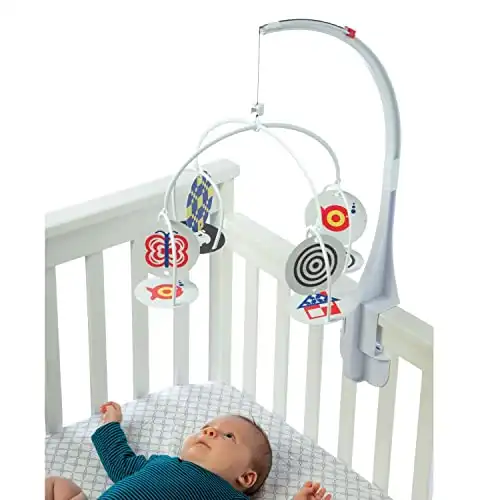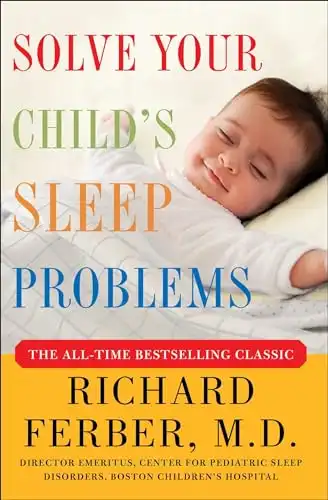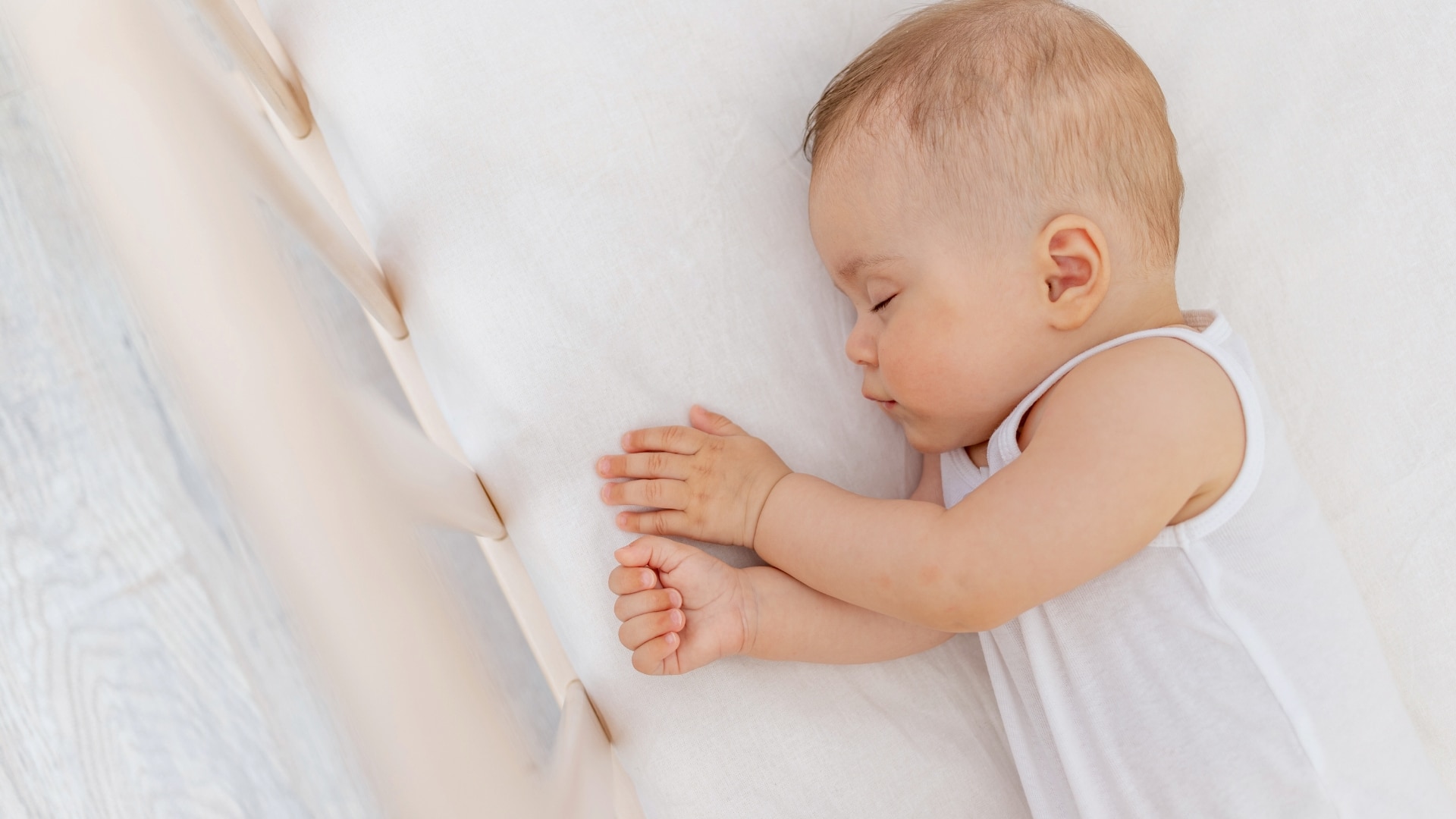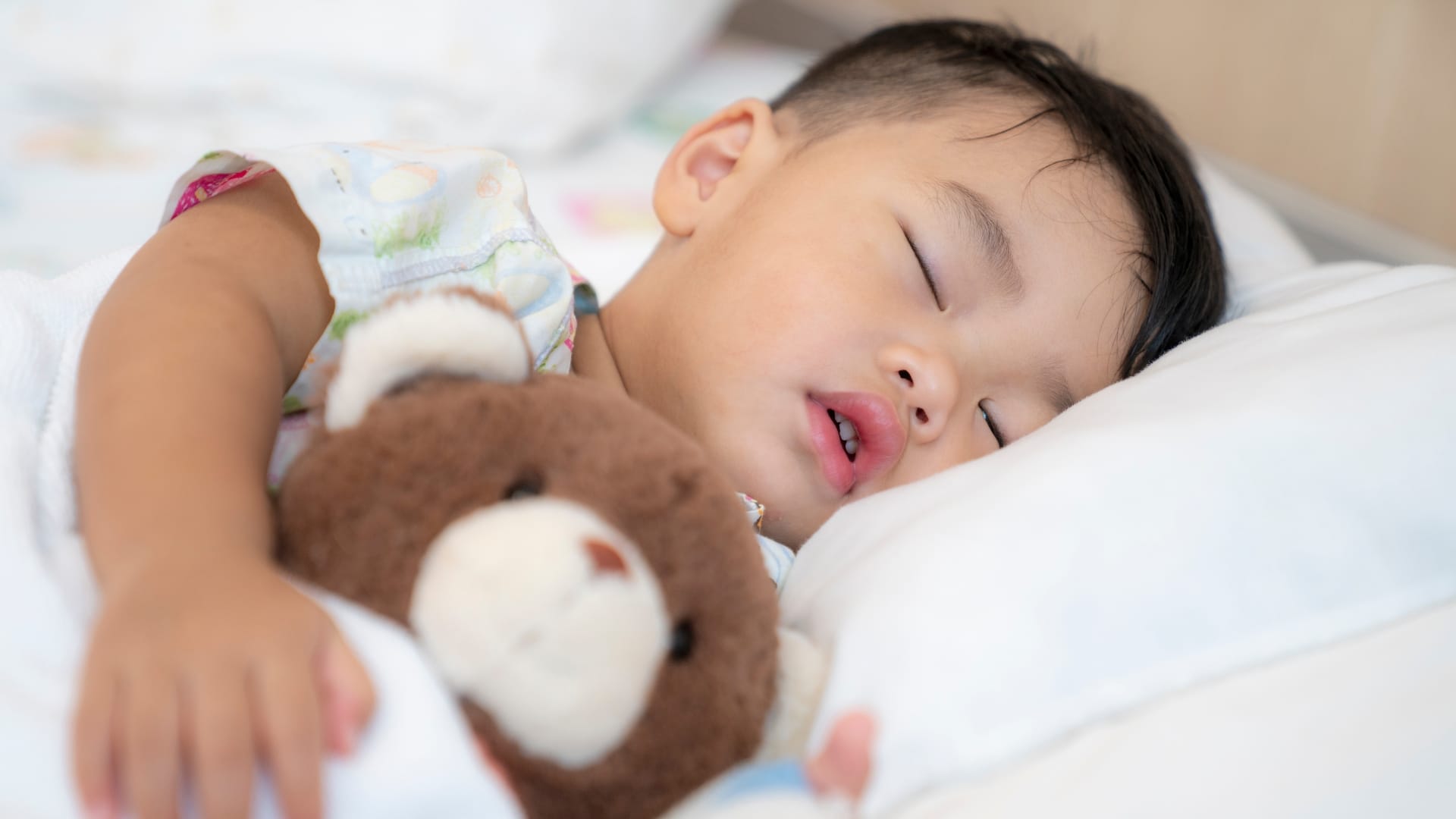Is your 7-month-old still waking multiple times a night, only sleeping when held, refusing to nap, and leaving you exhausted and desperate for a full night’s sleep? You’re not alone.
As well as establishing healthy sleep habits, sleep training a 7-month-old is one of the best ways to help your baby (and you) get the sleep you need.
In this guide, I will share with you over 40 years of childcare experience to help your baby learn to self-soothe and sleep for extended stretches. Keep reading to find out how to approach sleep training a 7-month-old in a way that works perfectly for your family.

Table of Contents
Key Takeaways
- Sleep training is the art of teaching your baby to fall asleep independently and through the night by developing healthy sleep habits and breaking negative associations. It’s typically recommended for babies over the age of 6 months as they start to develop self-soothing abilities.
- Several gentle sleep training methods are suitable for 7-month-old babies like the self-soothe technique, chair method, and fading sleep technique. The goal is to help baby learn to fall asleep on their own without much crying. The cry-it-out method is more intense and may not suit all families.
- To help sleep training go smoothly, establish a consistent routine, have an age-appropriate sleep schedule, create a sleep-friendly environment, and watch for and act on sleep cues promptly.
What Is Sleep Training?
Sleep training is when you teach your baby to fall asleep independently and sleep through the night. It involves developing healthy sleep habits and breaking negative sleep associations your baby may have developed. This is done by gradually teaching your baby to fall asleep on their own without the need for external soothing, such as contact napping, being rocked, or being fed to sleep.
Can You Safely Sleep Train A 7-Month-Old?
The American Academy of Pediatrics (AAP) suggests that you can start sleep training when your baby is around 4 to 6 months old.
So, yes, if your 7-month-old is struggling to sleep independently you can safely sleep train them.
At this age, your baby will have typically started to develop regular sleep patterns too, and be able to sleep for longer stretches, making sleep training more likely to succeed.
Looking to get your little one to sleep quickly and effortlessly? Check out my Bedtime and Nap Cheat Sheet and master the art of making daytime naps and bedtimes as seamless as possible.
A bedtime & nap cheat sheet so good your little one will ask you to put them to bed...
Laura Williams "This is a life saver! I'm so glad I downloaded your bedtime & nap cheat sheet. My little one actually asked me to put him to bed last night! Unbelievable! Thank you so much!"
Click Here For The FREE Cheat Sheet
Preparing For Sleep Training A 7-Month-Old
No matter what age you start sleep training, there are several things you should have in place before you embark upon a conventional method.
They will make sleep training run more smoothly and in some cases… these healthy sleep habits will stop you from needing to sleep train your baby at all.
This is because there is so much more to sleep training than just picking and implementing a method.
Here are my healthy sleep habits you must implement BEFORE considering conventional sleep training:
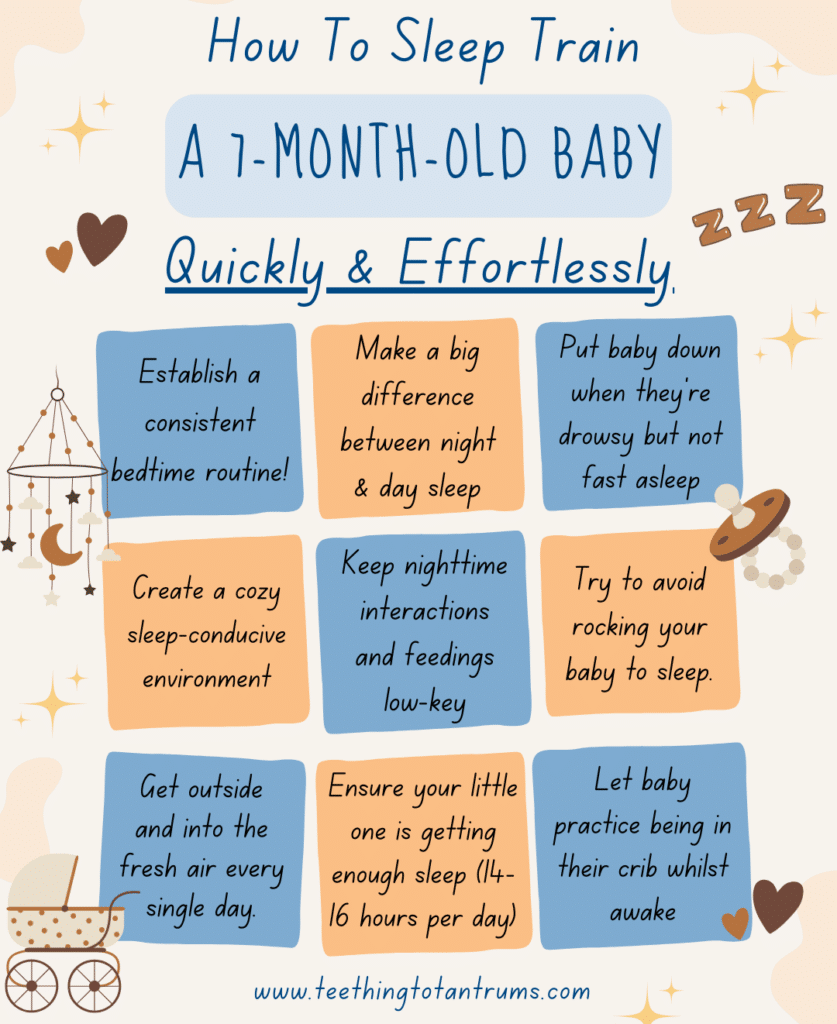
- Start to establish a recognizable and regular bedtime routine that includes a warm bath, and baby massage, followed by calming activities like reading or singing lullabies.
- Make a marked difference between daytime and nighttime sleep. Daytime naps can be accompanied by housework in the background, TV noises, and vacuuming, for example. Nighttime sleep should be dark, quiet, and cozy.
- Put baby down to sleep while drowsy but not fast asleep. I know this is easier said than done… but try to encourage your little one to fall into a deep sleep independently. Try warming their blankets so your 7-month-old is not getting into a cold crib and if they squirm slightly, gently rest your hand on their tummy to reassure them.
- Create a sleep-conducive environment in your baby’s room that is dimly lit and at the correct temperature. Use a white noise machine to prevent ambient noise from disturbing your little one especially if they are sleeping in the same room as you.
- Keep nighttime interactions and feedings low-key with little to no talking and no bright lights. Consider using a nightlight to help keep the sleep environment consistent.
- If your little one has been fed and changed, try and settle your baby back to sleep in their crib without rocking them to sleep in your arms.
- Get outside in the fresh air and natural light every day to balance your baby’s circadian rhythm and melatonin levels and promote healthy sleep.
- Ensure your little one is getting enough age-appropriate daytime sleep to avoid overtiredness which can disrupt the entire sleep schedule. Keep an eye on your baby’s wake windows to ensure they’re not awake for too long to prevent overstimulation. For a 7-month-old, this is typically around 2.5 to 3.5 hours. Read my post on the 7-month sleep schedule to learn what to expect.
- Let baby practice being awake and alone in the crib without the pressure of going to sleep. Putting your little one in the crib to look at an interesting mobile, like this one from Manhattan Toys while you take a quick shower is a good way of getting them used to being awake alone in their sleep space. This can help with teaching them to self-soothe and not always cry out on waking.
This award-winning crib mobile from the trusted Manhattan Toys range is perfect for entertaining your newborns without being overwhelming. It has 10 interchangeable cards that offer a range of simple high-contrast images to more complex coloured patterns and graphics to boost your little one's visual development!
Suitable Sleep Training Methods For A 7-Month-Old
OK, so if you’ve implemented all of my above tips and you’re still struggling to get your 7-month-old to spleen independently…
It’s time to implement a sleep training method.
When considering sleep training methods for your 7-month-old, it’s important to choose an approach that feels right for your family.
It’s also important that all caregivers are on the same page with the chosen method as this ensures consistency, which is essential for your little one to learn new sleep habits.
Here’s a look at some suitable sleep training methods for a 7-month-old baby:
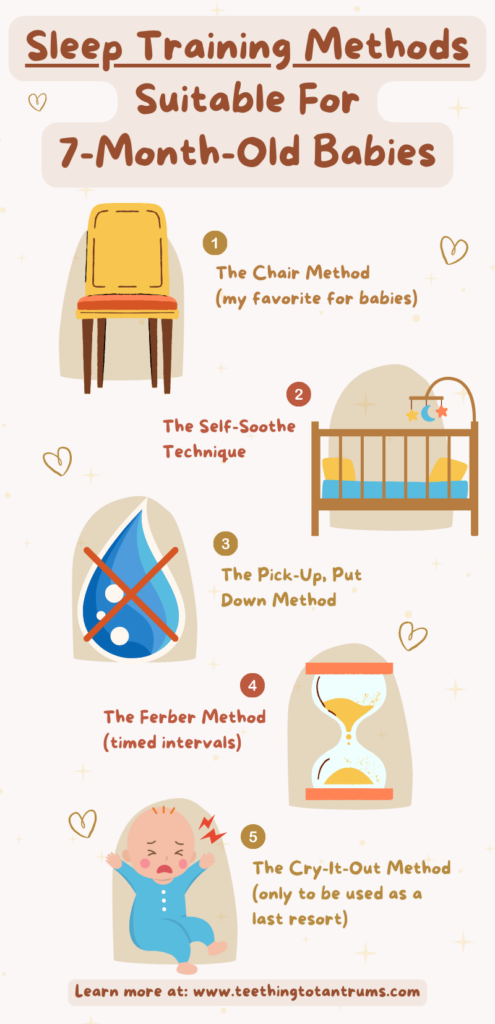
1. The Chair Method (My Favourite)
The Chair Method is one of my preferred methods for sleep training 7-month-old babies and one that I have found to be very effective.
To implement this gradual and comforting method, stay in the room with your little one after you have said goodnight, and sit next to their bed on a chair until they fall asleep.
Night after night, move the chair further away from the crib.
If your baby whines during the process, wait a little while to see if they’ll resettle by themselves. If they don’t, offer a pat or rub on the tummy to soothe your baby back to sleep before returning to your chair.
2. The Self-Soothe Technique
The Self-Soothe Sleep Method is a more subtle sleep training style and the one I would recommend you try if the Chair Method has not worked.
It involves helping your baby to fall asleep on their own without any assistance from you by putting into place a routine that gives them the best possible chance to fall asleep independently.
This means weaning off contact napping, having a consistent bedtime routine, putting your baby down when they are drowsy and not fast asleep, and gradually reducing the amount of time you spend with your baby settling them.
You can also consider using a pacifier at night if it helps your baby settle.
3. The Pick Up, Put Down Method
Also known as the “No Tears” approach, the Pick-Up, Put-Down method also involves putting your baby down when drowsy but not fast asleep… but unlike the Chair Method, you leave them for a short while, and if your baby fusses, you pick your baby up until they are calm then put them down again.
You repeat this method until your baby manages to fall asleep without being held.
As this is a gentle sleep training method, it will be less stressful for you and your baby, but it can take longer to achieve results. Therefore, the Pick Up, Put Down Method can be very tiring for parents.
But many have had great success with it so give it a try if your baby needs a lot of physical reassurance to settle.
TOP TIP: Don’t rush in every time your baby wakes. A little fussing is normal and you may find your baby re-settles themself after a few minutes.
4. The Ferber Method
The Ferber Method is a very well-known sleep training technique. It is commonly interchanged with Graduated Extinction, however, the difference is that the Ferber Method involves using set time intervals to leave your baby to cry before offering comfort (2 minutes, 5 minutes, 10 minutes).
It’s a structured approach that many parents find effective. However, at 7 months of age, I would recommend trying the Chair Method or the Self-Soothe technique first as these are gentler sleep training techniques.
To learn more about the Ferber Method read my post: Ferber Method: A Proven Sleep Training Technique For Infants
5. The Cry-It-Out
Also known as the extinction method, the Cry-It-Out (CIO) Method is a stricter sleep training approach where you say goodnight and leave your baby to fall asleep without returning. It can be challenging but yields quick results for some families.
I am not a fan of the cry-it-out method and believe it should only be used as a last resort if you’ve tried all of my tips and other techniques without success.
But I would not be doing my job if I didn’t provide you with all the options for sleep training a 7-month-old.
To learn more about the Cry-It-Out Method read this post: The Truth About The Cry-It-Out Method From A Norland Nanny
NOTE: If you are considering using the Cry-It-Out Method, be sure to check with a pediatrician to determine if it’s appropriate for your child BEFORE implementing its strategies.
How Long Does It Take To Sleep Train A 7-Month-Old?
As all babies are different… it is important to bear in mind that it might take a little while for your 7-month-old to adjust to your chosen sleep training method.
The truth is… there is no set time for how long sleep training at 7 months old can take and you may experience periods of success followed by periods of your little one waking more at night or struggling to settle.
In my experience, sleep training a 7-month-old can take anywhere from 3 days to 3 weeks for the change to stick.
TOP TIP: Night weaning can be integrated into your sleep training plans as most 7-month-olds can sleep through the night without feedings. Make sure they are getting enough food during the day to ensure they can go through the night and continue to implement a dream feed if it helps.

7-Month-Old Sleep Training For Naps
Nap training for your 7-month-old is all about creating consistency in your baby’s daytime sleep that reinforces the healthy sleep habits that you are trying to establish at night.
A 7-month-old’s total daily sleep should be around 14 hours, give or take two hours. This includes nighttime sleep and daytime naps.
A typical nap schedule includes a morning and afternoon nap. However, you need to take into account that at 7 months, your baby might be transitioning from three naps to two so may need an extra nap on busy days.
Establishing a pre-nap routine will also help your little one prepare for nap time. This can involve a book, cuddle, or lullaby before putting them down drowsy but awake.
Make the sleep environment conducive to sleep by using black blinds and a white noise machine or sleep app to help them settle.
Consistently putting your baby down for naps helps reinforce a regular sleep schedule and you must monitor sleep cues, like rubbing eyes and fussiness, to know when your 7-month-old is tired.
These signs tell you they are ready for sleep and should not be ignored.
It is more important to react swiftly to sleep cues and avoid trying to keep your baby awake to ‘fit in’ with your nap schedule.
To learn more about sleep training for naps, read this post: Sleep Training For Naps: The Tricks You Wish You Knew Sooner
TOP TIP: You may find you need to wake your 7-month-old up from their 3rd nap early to ensure they have an appropriate wake window before bedtime. Ideally, this final wake window should be 3.5 hours long.
Baby Sleep Training Books I Recommend
When implementing sleep training for your 7-month-old baby, it is really helpful to be well-informed about the subject.
Reading this article will certainly have helped!
But reading some books about specific sleep training methods will be even more helpful.
However, you must remember that your little one is a unique individual and you need to adapt to your baby’s individual needs.
Follow the advice that feels right for you and your baby and do not embark upon a sleep training method just because it is ‘supposed’ to work quickly.
I have read many books on the subject as well as acquired a lot of experience over the years about what sleep training method works for which age group.
So without further ado, here are a few books that I suggest reading when sleep training a 7-month-old baby.
1. Healthy Sleep Habits, Happy Child by Dr. Marc Weissbluth
A fantastic sleep training resource for parents of young babies is “Healthy Sleep Habits, Happy Child” by Dr. Marc Weissbluth. It’s full of research-based tips and a step-by-step plan to help you understand the importance of sleep and how to foster it in your baby’s life.
In this brilliant book, backed by decades of research and case studies, Dr. Weissbluth presents the Ferber method, a gentle form of sleep training that involves teaching babies to fall asleep independently with check-ins.
Charts and routines cover naps, nighttime sleep, and adjusting schedules. The book also addresses common issues like bedsharing, co-sleeping, night wakings, and daytime sleepiness giving you an all-inclusive sleep training approach!
- Provides individualized plans based on baby's exact age
- Evidence-based and developmentally appropriate
- Addresses a wide variety of common sleep questions
- Offers flexibility within routines based on baby's temperament and needs
- Teaches independent sleep skills
- Requires consistency to see full effects
- Focuses heavily on rigid routines and schedules
- May be overwhelming amount of information for some
- The adaption of the Ferber Method can be difficult for some babies to handle
2. The No-Cry Sleep Solution by Elizabeth Pantley
The No Cry Sleep Solution provides strategies that steer clear of letting your baby cry it out. Instead, it offers gentler alternatives to help your baby sleep through the night. It’s particularly favored by parents of 0-5 year olds seeking a softer sleep training method.
Gently guiding your toddler to better sleep becomes less of a battle with this book. The No-Cry Sleep Solution aims to provide you with researched, kind methods that respect your child's needs.
Implementing the tips provided feels relevant and doable, as each chapter follows through with advice matched to common situations.
What's truly beneficial is the understanding of sleep you gain. It's a relief to have your experiences validated and then addressed, flipping the script on bedtime struggles.
You're not just reading; you're learning and applying new strategies each night.
- Endorsed by many parents over the last 18 years for its effectiveness
- Focused on gentle techniques
- Includes valuable research insights
- Offers specific advice for 1-5 year olds
- Follows a gentle child-centred approach
- Covers a variety of bedtime issues such as night wakings and getting your toddler to stay in bed
- May not work for every child
- Some information might overlap with books you've previously read
- The solutions require patience and time
3. Solve Your Child’s Sleep Problems by Richard Ferber
The sleep training classic, Solve Your Child’s Sleep Problems, has been revised and updated to deal with bedtime battles, nighttime waking, sleep terrors, and bedwetting in our modern world.
Though the book is vast, it’s a well of wisdom and you will find it addresses situations many other books do not.
Patience is key when implementing the techniques laid out, but persistence transforms nights from waking nightmares into peaceful slumber.
Will Sleep Training Harm Babies?
Contrary to some concerns, sleep training done properly does not harm children. Research shows it can actually benefit both parents and babies.
A study by the American Academy of Pediatrics divided infants into two groups – one went through sleep training, and the other did not. They measured the babies’ cortisol stress levels, parental satisfaction, parental stress, and the children’s attachment styles at one year old.
Results found that babies who were sleep-trained had decreased cortisol by the end of the training, indicating lower stress.
And at one year old, there was no difference in attachment style or behavior between the groups.So with the right methods and environment, sleep training helps babies learn to self-soothe without negatively impacting development.
Addressing Common Sleep Training Challenges
Sleep training can be a challenge but there are lots of things you can do to deal with common setbacks effectively.
- Teething and Illness: These challenges can naturally disrupt sleep but they do not require ‘sleep training’. The most important thing you can do for your baby is provide lots of love and comfort (pacifier or teething toys) and consult with your pediatrician if you have any concerns. Once your baby is better, you can then resume your preferred sleep training method.
- Check for stressors: Stress can affect your baby’s sleep. If there has been a major change in routine their sleep can easily be disrupted. Whatever is going on try to maintain a peaceful and cozy sleep environment and a routine to instill security. White noise machines and audio apps are great ways to offer comfort during this phase. Consider using a night light too.
- Sleep Regression: Sleep regressions can occur at any age for a large variety of reasons and they can certainly lead to your baby struggling to fall asleep independently and deal with nighttime waking. You must stay consistent with bedtime practices and offer lots of love and assurance to your child during this transition. To learn more about how to handle the 7-month sleep regression, read this post: The 7-Month Sleep Regression Survival Guide
- Night Wakings: If your little one is waking at night and struggling to re-settle, always check to make sure your baby is not unwell or in any discomfort, and then re-settle them with your chosen sleep training method. Keep your interactions brief and soothing.
- Daytime Sleep: This is very important as adequate age-appropriate naps will reduce the chances of overtiredness. An overtired baby will most definitely struggle to fall asleep and stay asleep so getting daytime sleep right can be a game changer and improve nighttime sleep significantly. Aim for two naps a day, each 1-2 hours long.
It's Time To Say Goodbye To 2 am Wake-Up Calls 🌜👶
In Nighttime Nurturing you'll learn the art of handling nighttime wakings as well as develop your understanding of why nighttime wakings happen to drastically reduce their frequency and focus on gentle yet powerful methods to encourage your little one to sleep through the night
This isn’t about quick fixes; it’s about sustainable changes that foster independence in your child’s sleep habits. Here's what you'll master:
✅ Strategies to reduce the overall frequency of wakings, ensuring more peaceful and solid blocks of sleep for everyone.
✅ Insights into creating a stress-free bedtime routine that sets the tone for a successful night, aligning with natural sleep cycles to become a cherished part of the day.
✅ Techniques to soothe your child back to sleep quickly and gently, minimizing any further disruptions.
✅ Foster a closer, more harmonious relationship with your child by understanding and addressing their sleep needs effectively.
✅ Tools to empower your child to become an independent sleeper, instilling confidence and security in them. Including the 1 KEY skill, you must teach your child to stop them from needing you!
Ready to reclaim your well-earned solid nights of sleep again? Learn more here! 👉
Can You Sleep Train During The 7-Month Sleep Regression?
At 7 months old, your baby may very well experience a sleep regression which is characterized by more frequent wakings, resistance to nap, and increased fussiness and clinginess.
However, the good news is that you can still sleep train during the 7-month sleep regression.
Consistency when it comes to sleep is always key, especially when your baby is going through sleep disruptions.
To navigate the 7-month sleep regression with your sleep training effort intact, consider the following:
- Stick to a calming regular bedtime routine to signal that it’s time to rest. Include a warm bath, baby massage, and baby books to get them primed for sleep.
- Utilize a dream feed to get your little one through the night.
- Continue to put baby down when they’re drowsy but not fast asleep and always act on sleep cues to avoid overtiredness.
- Try to avoid overtiredness by making up for bad nighttime sleep with an extra daytime nap. Remember to keep an eye on the amount of sleep your baby is getting in 24 hours. A 7-month-old baby needs around 14 hours of sleep per day.
- Get outside every day in the natural light and fresh air to balance their circadian rhythm
- Make sure your 7-month-old has lots of opportunities to practice any new skill they may be mastering.
REMEMBER: If your 7-month-old is transitioning from 3 naps to 2 you may need to accommodate a cat nap later in the day of no more than 30 mins to get them through to bedtime without becoming overtired.

When To Seek Medical Advice
You should always keep a close eye on your baby’s development… even more so when you are going through a period of sleep training.
It is important that you are happy that your little one is fit and ready for the challenge of learning to self-soothe.
Therefore, if anything feels off or you notice any unusual changes in behavior, it is a good idea to consult your pediatrician.
Changes in sleep patterns can sometimes indicate a medical concern and your infant’s health is a top priority during sleep training.
Listed below are reasons to seek medical advice when sleep training a 7-month-old:
- Your baby seems excessively tired or lethargic during the day.
- There are significant changes in eating habits alongside sleep concerns.
- Baby’s weight has changed dramatically alongside unusual sleeping habits.
- You observe behaviors or symptoms that are not typical for your baby.
Milestones, growth, and development are always intertwined with sleep. If your child is not making expected progress, a medical professional should evaluate them.
The pediatrician can offer guidance tailored specifically to your baby’s needs and most importantly, they can verify whether your baby is on track with growth and development milestones.
Remember, seeking advice is a proactive step in ensuring your child’s well-being. If you have any doubts about your infant’s health or sleep habits, don’t hesitate to reach out to a healthcare provider.
NOTE: Keeping track of your baby’s nap and nighttime sleep in a diary is an incredibly valuable asset if you need to talk to a pediatric sleep consultant about your little one’s sleeping habits.
With one spacious page dedicated to each day, you'll have plenty of room in this delightful planner to write down all your to-dos, appointments, and notes for the year.
Ideal for parents tracking baby's sleep, feeding, and pooping schedules...
Or a sleep journal for toddlers...
Whatever your requirements for the diary need to be, this handy planner will tick the right boxes.
Frequently Asked Questions About Sleep Training A 7-Month-Old
When considering sleep training your 7-month-old, you may have several questions. This section aims to address common concerns I have been asked from parents over the years.
Q: What methods are effective for sleep training a breastfed 7-month-old baby at night?
A: No matter how your baby is fed for this age, I would still recommend a gentle approach to sleep training. At 7 months your baby is capable of sleeping through the night without a feed but you must ensure your little one is getting enough to eat during the day and the lead-up to bedtime. Remember to have a regular and calming bedtime routine and keep nighttime feedings quiet and low-lit so baby learns night is for sleep.
Q: Can you use the cry-it-out method with a 7-month-old, and if so, for how long?
A: Yes, the cry-it-out method can be used at 7 months. The Cry-It-Out method does not have a set period for crying. Instead, you leave baby to cry themselves to sleep. If you prefer timed intervals, consider using the Ferber method.
Q: Are there any specific techniques to help a 7-month-old sleep through the night reliably?
A: Establishing a bedtime routine is crucial for consistent sleep. This may include a warm bath, baby massage, reading a book, or gentle cuddling. Keep the environment conducive to sleep with dim lights and a comfortable temperature and always put your little one down to sleep drowsy avoiding rocking or feeding to sleep.
Q: What strategies are recommended for adjusting a 7-month-old’s sleep schedule?
A: To adjust a sleep schedule, slowly shift bedtimes and naptimes. Move the times in 15-minute increments each day until the desired schedule is reached. Consistency and patience are essential during this process. Also, be prepared to wake your baby from a nap to create the appropriate awake windows necessary for them to be ready for sleep at the right time (about 3.5 hours).
Q: Is seven months a suitable age to start sleep training, or is it considered too late?
A: Seven months is certainly a suitable age for sleep training. It’s not too late, as many babies develop more predictable sleep patterns around this age.
Q: How can the nap schedule affect nighttime sleep training for a 7-month-old?
A: A consistent nap schedule can improve nighttime sleep by helping to avoid overtiredness. At 7 months, two naps a day are common, but tailor the schedule to your baby’s needs as they may need 3 naps on busy days. Ensure naps aren’t too close to bedtime to prevent challenges in falling asleep at night.
Need More Parenting Help?
- Download our FREE Perfect Sleep Cheat Sheet. It’s a free, easy-to-use and proven formula designed for parents of 0-5 year olds to master the art of consistently undisturbed and restful sleep without the yelling, nagging or exhausting long-winded evenings.
- Check out our Parenting Toolbox. You’ll get access to expertly-chosen products that you can guarantee are the best for your little one and your wallet.
- Ready to create the calm, peaceful evenings you deserve? Then checkout our most popular course - The Bedtime Battles Masterclass

A bedtime & nap cheat sheet so good your little one will ask you to put them to bed...
Laura Williams "This is a life saver! I'm so glad I downloaded your bedtime & nap cheat sheet. My little one actually asked me to put him to bed last night! Unbelievable! Thank you so much!"
Click Here For The FREE Cheat Sheet
